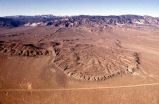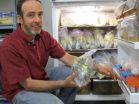(Press-News.org) DURHAM, N.C. – Alternating hemiplegia of childhood (AHC) is a very rare disorder that causes paralysis that freezes one side of the body and then the other in devastating bouts that arise at unpredictable intervals. Seizures, learning disabilities and difficulty walking are common among patients with this diagnosis.
Researchers at Duke University Medical Center have now discovered that mutations in one gene cause the disease in the majority of patients with a diagnosis of AHC, and because of the root problem they discovered, a treatment may become possible.
The study was published online on July 29 in Nature Genetics.
AHC is almost always a sporadic disease, which means that typically no one else in the family has the disease, said Erin Heinzen, Ph.D., co-author of the study and Assistant Professor of Medicine in the Section of Medical Genetics. "Knowing that we were looking for genetic mutations in children with this disease that were absent in the healthy parents, we carefully compared the genomes of seven AHC patients and their unaffected parents. When we found new mutations in all seven children in the same gene we knew we had found the cause of this disease."
All of the mutations were found in a gene that encodes ATP1A3, one piece of a key transporter molecule that normally would move sodium and potassium ions across a channel between neurons (nerve cells) to regulate brain activity.
In a remarkably broad international collaborative effort, the authors partnered with three family foundations (USA, Italy and France), including scientists from 13 different countries, to study an additional 95 patients and showed over 75 percent had disease-causing mutations in the gene for ATP1A3.
"This study is an excellent example of how genetic research conducted on a world-wide scale really can make a difference for such a rare disorder as AHC," said Arn van den Maagdenberg, Ph.D., and co-author on the study and geneticist from Leiden University Medical Centre in the Netherlands. "It truly was an effort from many research groups that led to this remarkable discovery."
"This kind of discovery really brings home just what the human genome project and next-generation sequencing have made possible," said David Goldstein, Ph.D., Director of the Duke Center for Human Genome Variation and co-senior author on the study. "For a disease like this one with virtually no large families to study, it would have been very difficult to find the gene before next-generation sequencing."
"Ideally what you want from a study like this is a clear indication of how the mutations change protein function so you know how to screen for drugs that will restore normal function or compensate for the dysfunction," said Goldstein, who is also a Professor in Duke Molecular Genetics and Microbiology. "While there is considerably more work to do, our initial evaluation of the mutations suggests that they may alter the behavior of the transporter pump as opposed to reducing its activity, as do other mutations in the gene that cause a less severe neurological disease."
Co-senior author Mohamad Mikati, M.D., Professor of Pediatrics and of Neurobiology, and Chief of Pediatric Neurology at Duke, said, "Many years ago my work with other collaborators on a family with this disease proved that AHC can be caused by genetic factors, but until now we did not know the underlying gene abnormality.
"The finding that ATP1A3 mutations cause AHC will increase awareness of the disease and the ability to accurately diagnose patients," Mikati said. "While it may take a while for novel drugs to be developed to better treat this disease, we will see an immediate impact through specific testing for mutations in this gene when we suspect a case of AHC. This direct testing will prevent misdiagnoses that too often have caused patients to be treated with inappropriate medications."
###
Other authors worked at the University of Utah, Salt Lake City; Università Cattolica Sacro Cuore, Rome; UPMC Univ Paris, INSERM, CNRS and Groupe Hospitalier de la Pitié-Salpêtrière, in Paris; Leiden University Medical Centre, Leiden, The Netherlands; University of Melbourne, Melbourne, Australia; University Hospitals of Lyon, France; University of Chicago, Illinois; University of California, San Francisco; Rijnland Hospital, Leiderdorp, The Netherlands; Sydney Children's Hospital, Randwick, and University of Sydney, New South Wales, Australia; Royal Hobart Hospital, Hobart, Australia; Our Lady's Children's Hospital, Crumlin, and the Childrens University Hospital, Dublin, Ireland; Rigshospitalet, University of Copenhagen; CRNL, CNRS INSERM, in Lyon, France; and UCL Institute of Neurology, London.
The study was funded by the Center for Human Genome Variation, the Alternating Hemiplegia of Childhood Foundation, the ENRAH for SMEs Consortium grant of the European Commission Research Programme, Association Française de l'Hémiplégie Alternante, A.I.S.EA Onlus, CMSB within the Netherlands Genomics Initiative, the Wellcome Trust, and the University of Utah.
END
"We see landslides everywhere in the solar system," says Kelsi Singer, graduate student in earth and planetary sciences in Arts & Sciences at Washington University in St. Louis, "but Saturn's icy moon Iapetus has more giant landslides than any body other than Mars."
The reason, says William McKinnon, PhD, professor of earth and planetary sciences, is Iapetus' spectacular topography. "Not only is the moon out-of-round, but the giant impact basins are very deep, and there's this great mountain ridge that's 20 kilometers (12 miles) high, far higher than Mount Everest.
"So ...
On a time scale of tens to hundreds of millions of years, the geomagnetic field may be influenced by currents in the mantle. The frequent polarity reversals of Earth's magnetic field can also be connected with processes in the mantle. These are the research results presented by a group of geoscientists in the new advance edition of "Nature Geoscience" on Sunday, July 29th. The results show how the rapid processes in the outer core, which flows at rates of up to about one millimeter per second, are coupled with the processes in the mantle, which occur more in the velocity ...
July 29th, 2012, Shenzhen, China – A five-country international team, led by Casey Eye Institute Molecular Diagnostic laboratory, BGI and Zhejiang University School of Medicine First Affiliated Hospital identified the NMNAT1 mutations as a cause of Leber congenital amaurosis (LCA), one of the most common causes of inherited blindness in children. The latest study was published online in Nature Genetics, reporting the genetic characteristics underlying some LCA patients, and providing important evidences that support NMNAT1 as a promising target for the gene therapy of LCA.
LCA ...
CORVALLIS, Ore. – The chronic drought that hit western North America from 2000 to 2004 left dying forests and depleted river basins in its wake and was the strongest in 800 years, scientists have concluded, but they say those conditions will become the "new normal" for most of the coming century.
Such climatic extremes have increased as a result of global warming, a group of 10 researchers reported today in Nature Geoscience. And as bad as conditions were during the 2000-04 drought, they may eventually be seen as the good old days.
Climate models and precipitation projections ...
TORONTO, ON – Researchers from the University of Toronto (U of T) and King Abdullah University of Science & Technology (KAUST) have made a breakthrough in the development of colloidal quantum dot (CQD) films, leading to the most efficient CQD solar cell ever. Their work is featured in a letter published in Nature Nanotechnology.
The researchers, led by U of T Engineering Professor Ted Sargent, created a solar cell out of inexpensive materials that was certified at a world-record 7.0% efficiency.
"Previously, quantum dot solar cells have been limited by the large internal ...
After the fall of the Soviet Union twenty years ago, water distribution in Central Asia became a source of conflict. In areas where summer precipitation is low, glaciers play an important role when considering the quantity of available water. The Tien Shan region is a prime example; mountain glaciers in this region contribute significantly to the fresh water supply in the arid zones of Kyrgyzstan, Kazakhstan, Uzbekistan, Turkmenistan, and Northwestern China. Like Switzerland, Kyrgyzstan serves as a water tower for its neighboring countries.
While the impact of climate ...
SALT LAKE CITY, July 30, 2012 – In the years after Columbus' voyage, burning of New World forests and fields diminished significantly – a phenomenon some have attributed to decimation of native populations by European diseases. But a new University of Utah-led study suggests global cooling resulted in fewer fires because both preceded Columbus in many regions worldwide.
"The drop in fire [after about A.D. 1500] has been linked previously to the population collapse. We're saying no, there is enough independent evidence that the drop in fire was caused by cooling climate," ...
HAMILTON, ON (July 30, 2012) – Child abuse experts say psychological abuse can be as damaging to a young child's physical, mental and emotional health as a slap, punch or kick.
While difficult to pinpoint, it may be the most challenging and prevalent form of child abuse and neglect, experts say in an American Academy of Pediatrics (AAP) position statement on psychological maltreatment in the August issue of the journal Pediatrics.
Psychological abuse includes acts such as belittling, denigrating, terrorizing, exploiting, emotional unresponsiveness, or corrupting a child ...
A new analysis has found that doing away with PSA (prostate specific antigen) testing for prostate cancer would likely cause three times as many men to develop advanced disease that has spread to other parts of the body before being diagnosed. Published early online in CANCER, a peer-reviewed journal of the American Cancer Society, the study suggests that PSA testing and early detection may prevent approximately 17,000 men each year from having such advanced prostate cancer at diagnosis.
PSA testing has come under fire recently as a potentially ineffective screen for ...
Eliminating the PSA test to screen for prostate cancer would be taking a big step backwards and would likely result in rising numbers of men with metastatic cancer at the time of diagnosis, predicted a University of Rochester Medical Center analysis published in the journal, Cancer.
The URMC study suggests that the prostate-specific antigen (PSA) test and early detection may prevent up to 17,000 cases of metastatic prostate cancer a year. Data shows, in fact, that if age-specific pre-PSA era incidence rates were to occur in the present day, the number of men whose cancer ...

